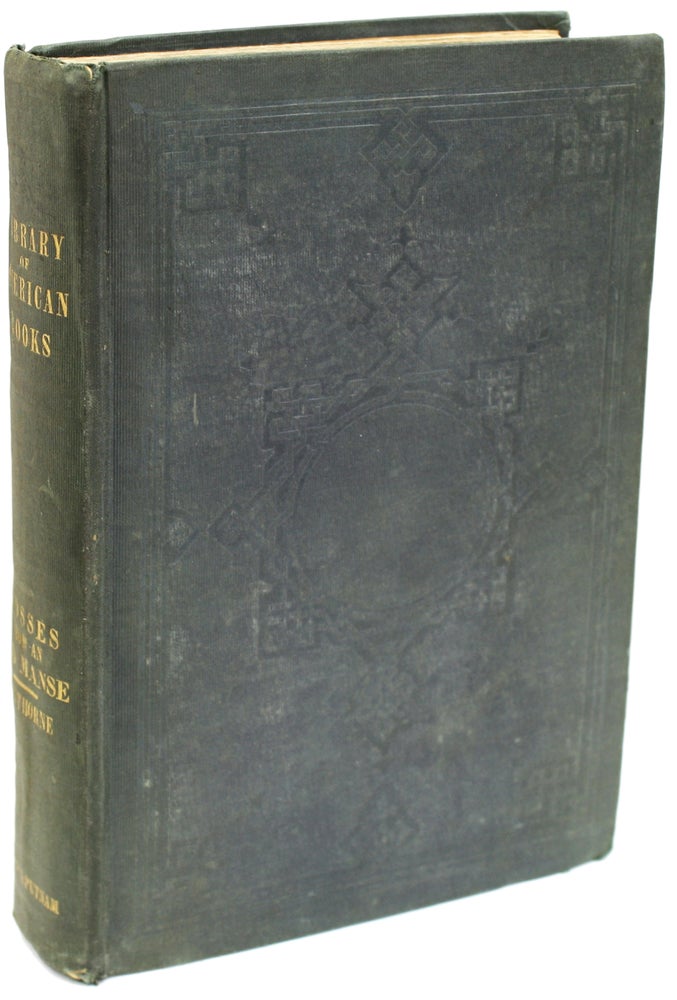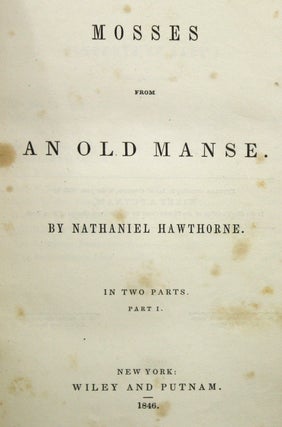MOSSES FROM AN OLD MANSE. New York: Wiley and Putnam, 1846. 12mo, two volumes in one: pp. [1-6] [1] 2-207 [208: blank]; [1-6] [1] 2-211 [212: blank], half title leaves present, publisher's original decorated gray-green cloth, front and rear panels stamped in blind, spine panel stamped in gold and blind, pale yellow endpapers, top edge untrimmed. First edition. An early printing (a mixture of second and third printing sheets) with Smith and Craighead imprints present on both copyright pages and page [212] of volume two blank (in subsequent printings page [212] is used as the title page for a publisher's catalogue). According to BAL "when issuing the book in cloth (as a single volume) the publishers used whatever sheets they had in stock, and copies in cloth, therefore, frequently are of intermediate status." The second of Hawthorne's three major collections of short fiction published in his lifetime, and the best and most important of the three. Includes a number of classics, "The Birth-Mark," "Young Goodman Brown," "Rappaccini's Daughter" and "The Artist of the Beautiful." The other fantasy stories are "A Select Party," "Mrs. Bullfrog," "The Hall of Fantasy," "The Celestial Railroad," "The New Adam and Eve," "Egotism; or the Bosom Friend," "The Christmas Banquet," "Roger Malvin's Burial," "P.'s Correspondence," "Earth's Holocaust," and "A Virtuoso's Collection." "P.'s Correspondence," appears to be the first American alternate history story. "The darkness of his vision of the human psyche gives to almost everything he wrote, even works which were not supernatural fiction or fantasy, a sense that its protagonists are acting in obedience to the Gothic manipulations of the dead but shaping past, that they can never simply flourish in the here and now. It is in something like this sense that so much of his work seems to have been treated as allegory: his characters are so in bondage to the stories they have been appointed to undergo that they seem to 'stand' in an allegorical relationship to symbolic events, rather than to live them ... In the end, the Hawthorne romance of predetermination casts a long shadow over the American Dream, telling us that we must both dream very hard and surrender absolutely." - Clute and Grant (eds), The Encyclopedia of Fantasy (1997), p. 457. Anatomy of Wonder (1976) 1-16; 1-17; 1-18; and 1-19; (1981) 1-96; and (2004) II-505. Barron (ed), Fantasy Literature 2-79. Barron (ed), Horror Literature 2-39. Bleiler, The Guide to Supernatural Fiction 777. Bleiler, Science-Fiction: The Early Years 1070. Clute and Nicholls (eds), The Encyclopedia of Science Fiction (1993), p. 551. Sullivan (ed), The Penguin Encyclopedia of Horror and the Supernatural, pp. 196-99. Survey of Modern Fantasy Literature III, pp. 1536-43. Survey of Science Fiction Literature IV, pp. 2035-40. Bleiler (1978), p. 96. Reginald 06958. Wright (I) 1143. BAL 7598. Clark A15.1.a. Lower corner tips worn, lower spine end worn and repaired, mild foxing to preliminaries, but overall, a very nice copy, quite superior to most extant copies. A seminal work of early American fantastic literature by one of the two (the other was Poe) founding fathers of modern American imaginative fiction. (#155571).
Price: $1,500.00
No statement of printing.



